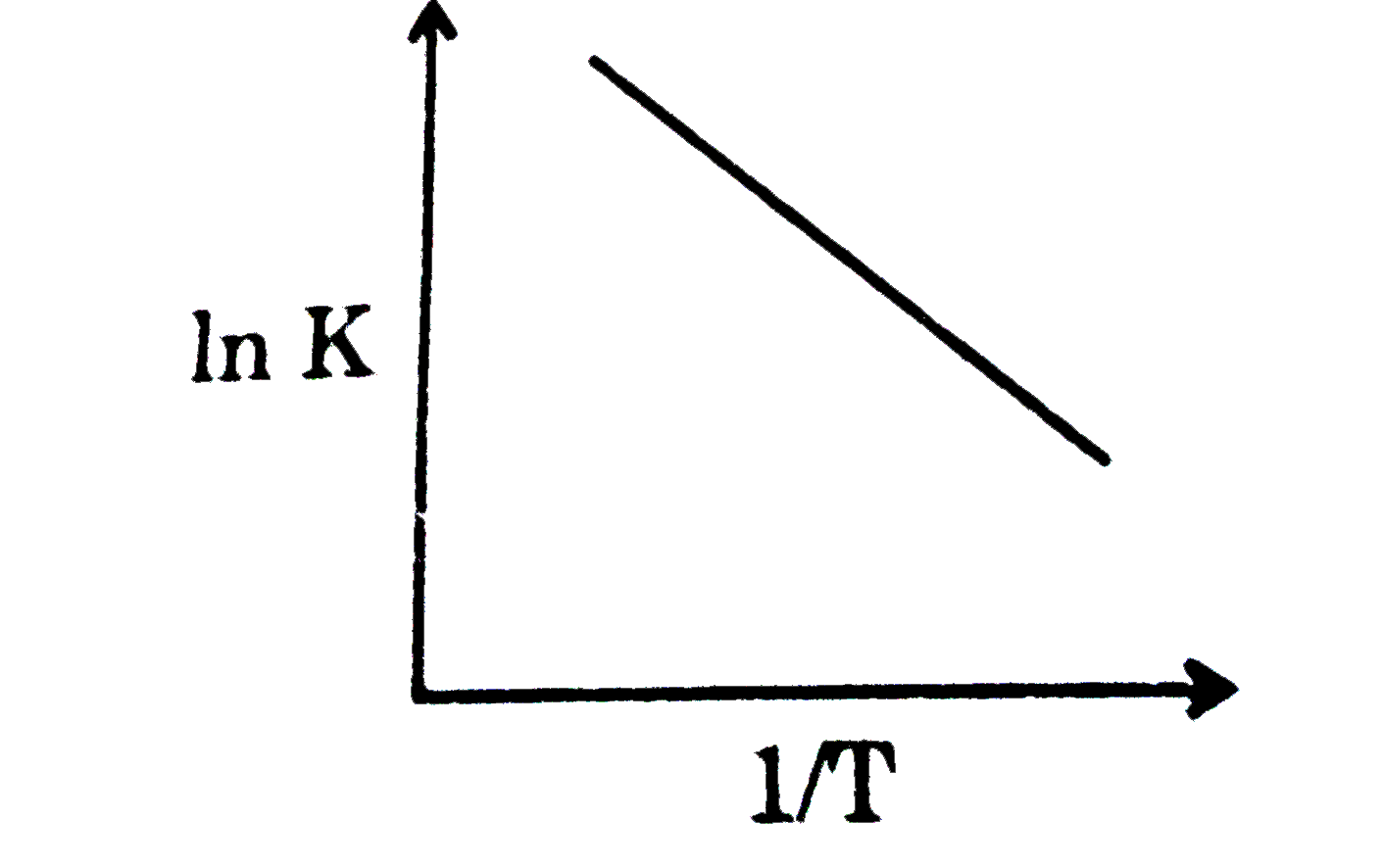For the given reaction.
2A(s)+B(g)⇔C(g)+2D(s)+E(s)
the degree of dissociation of B was found to be 20% at 300k and 24% at 500 k the rate of backward reaction
increases with increase in pressure and temperature
increases with increases in pressure and decreases in temperature
depends on temperature only and decreases with increases in temperature
increases with increasing the concentration of B and increasing the temperature
The correct Answer is:C
To solve the question regarding the degree of dissociation of B and the rate of the backward reaction, we can follow these steps:
Step 1: Understand the Reaction
The given reaction is:
2A(s)+B(g)⇌C(g)+2D(s)+E(s)
In this reaction, B is a gaseous reactant, and its degree of dissociation is given at two different temperatures.
Step 2: Define Degree of Dissociation
The degree of dissociation (α) is defined as the fraction of the original amount of a substance that has dissociated. For B, we have:
- At 300 K, α = 20% = 0.20
- At 500 K, α = 24% = 0.24
Step 3: Analyze the Effect of Temperature
The degree of dissociation of B increases with temperature. This indicates that the forward reaction is favored at higher temperatures. According to Le Chatelier's principle, if the forward reaction is favored, the rate of the backward reaction will decrease as temperature increases.
Step 4: Determine the Rate of Backward Reaction
The rate of the backward reaction is influenced by the concentration of products and the temperature. As the temperature increases, the rate of the forward reaction increases, leading to a decrease in the rate of the backward reaction.
Step 5: Evaluate the Options
Now, we need to evaluate the options provided in the question regarding how the rate of the backward reaction changes with pressure and temperature.
1. Option 1: Increase with increase in pressure and temperature.
- Incorrect. The rate of reaction is independent of pressure in this case, and the backward reaction decreases with increasing temperature.
2. Option 2: Increase with increase in pressure.
- Incorrect. As established, the rate of reaction is independent of pressure.
3. Option 3: Depend on temperature only.
- Correct. The rate of the backward reaction decreases with an increase in temperature.
4. Option 4: Increase with increase in concentration of B.
- Incorrect. Increasing the concentration of B will favor the forward reaction, thus decreasing the rate of the backward reaction.
Conclusion
The correct answer is Option 3: The rate of the backward reaction depends on temperature only and decreases with an increase in temperature.
---
The given reaction is:
2A(s)+B(g)⇌C(g)+2D(s)+E(s)
The degree of dissociation (α) is defined as the fraction of the original amount of a substance that has dissociated. For B, we have:
- At 300 K, α = 20% = 0.20
- At 500 K, α = 24% = 0.24
The degree of dissociation of B increases with temperature. This indicates that the forward reaction is favored at higher temperatures. According to Le Chatelier's principle, if the forward reaction is favored, the rate of the backward reaction will decrease as temperature increases.
The rate of the backward reaction is influenced by the concentration of products and the temperature. As the temperature increases, the rate of the forward reaction increases, leading to a decrease in the rate of the backward reaction.
Now, we need to evaluate the options provided in the question regarding how the rate of the backward reaction changes with pressure and temperature.
- Incorrect. The rate of reaction is independent of pressure in this case, and the backward reaction decreases with increasing temperature.
- Incorrect. As established, the rate of reaction is independent of pressure.
- Correct. The rate of the backward reaction decreases with an increase in temperature.
- Incorrect. Increasing the concentration of B will favor the forward reaction, thus decreasing the rate of the backward reaction.
The correct answer is Option 3: The rate of the backward reaction depends on temperature only and decreases with an increase in temperature.
Topper's Solved these Questions
- CHEMICAL EQUILIBRIUMBook:FIITJEEChapter:CHEMICAL EQUILIBRIUMExercise:ASSIGNMENT PROBLEMS (OBJECTIVE (LEVEL -I) REASONING TYPE QUESTIONS))
Explore 6 Videos
- CHEMICAL EQUILIBRIUMBook:FIITJEEChapter:CHEMICAL EQUILIBRIUMExercise:ASSIGNMENT PROBLEMS (OBJECTIVE ( LEVEL -II))
Explore 20 Videos
- CHEMICAL EQUILIBRIUMBook:FIITJEEChapter:CHEMICAL EQUILIBRIUMExercise:ASSIGNMENT PROBLEMS (OBJECTIVE)
Explore 3 Videos
- CHEMICAL ENERGETICS Book:FIITJEEChapter:CHEMICAL ENERGETICS Exercise:NUMERICAL BASED QUESTIONS
Explore 2 Videos
- CHEMICAL KINETICS AND RADIOACTIVITYBook:FIITJEEChapter:CHEMICAL KINETICS AND RADIOACTIVITYExercise:Exercise
Explore 9 Videos
Similar Questions
Knowledge Check
The Kc for given reaction will be A2(g)+2B(g)⇔C(g)+2D(s)
AK=[C][D]2[A2][B]2BK=[C][A2][B]2CK=[A2][B]2[C][D]2DK=[A2][B]2[C]For the reaction: 2A(g)<⇒3B(g)+C(g),Kp=2.7×10−9atm2 at 298 K. The degree of dissociation of A(g) at 298 K and 40 atm is-
A0.1B0.001C0.001D0.0001For reaction, 2A(g)⇔3C(g)+D(s), the value of Kc will be equal to
AKp(RT)BKp/RTCKpDNone of these
For the reaction, A(g)+B(s)⇔C(g)+D(g).Kc=49molL−1at127∘C. Calculate kp.
View SolutionFor the reaction A(g)+B(s)⇔C(g)+D(g),Kc=49moldm−3 at 127∘C. Calculate Kp.
View SolutionFor the reaction, SnO2(s)+2H2(g)⇔Sn(l)+2H2O(g) the equilibrium mixture of steam and hydrogen contained 45% and 24%H2 at 900K and 1100K respectively. Calculate Kp at both the temperature. Generally should it be higher or lower temperatures for better reduction of SnO2?
View SolutionMass action ratio or reaction quotient Q for a reaction can be calculated using the law of mass actionl,
A(g)+B(g)⇔C(g)+D(g)
Q=[C][D][A][B]
The value of Q decides whether the reaction is at equilibrium or not.
At equilibrium, Q=K
For non-equilibrium process Q≠K
When Q>K, reaction will be favoured in backward direction and when Q<K, it will be favoured in forward direction.
In the following reaction :
2SO2(g)+O2(g)⇔2SO3(g)
The equilibrium is not attained. The rate of forward reaction is greater than that of backward reaction. Thus, which of the following is the correct relation between Kp and Qp?
View SolutionConsider the following reaction :
2A(s)+3B(g)⇔2C(g)+2D(g)
For given reaction, graph which is followed between ln k and 1/T is:

Which of the following statement(s) is/are incorrect ?
View Solution

